 There is something very wrong with the following “silent movie cliché.” See if you can spot it.
There is something very wrong with the following “silent movie cliché.” See if you can spot it.
The saw blade glints and turns hungrily as the damsel in distress, bound and gagged, inches closer and closer towards certain death. Suddenly, the hero (you may be imagining him in a Mountie uniform) bursts into the sawmill and unties the damsel in distress, preferably at the last possible minute.
What’s the flaw? Simple: in the most famous sawmill scene of the silent era, the finale of John H. Collins’s Blue Jeans, the heroine saves the hero, not the other way around. As June, the film’s ragamuffin protagonist, Viola Dana not only rescues her husband from being sliced in half at the end, but also battles corrupt politicians and defies small-town hypocrisy.
Last weekend, Capitolfest screened a 35mm print of Blue Jeans from the George Eastman House. Unavailable on DVD, this forgotten classic invests the stock types and baroque storylines of 19th century melodrama with rawness and urgency. Although hampered by an uncharismatic leading man, the film has lost little of its rousing entertainment value and suspenseful momentum almost 100 years after its release.
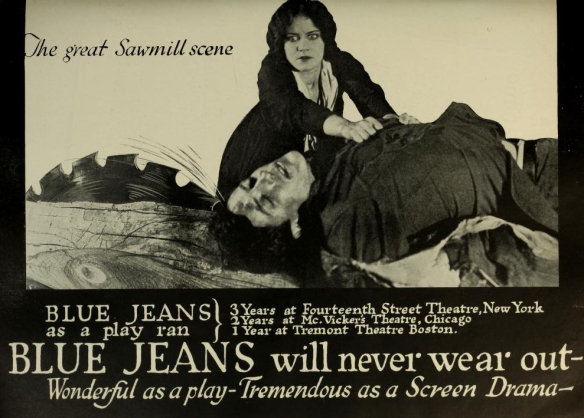
Most important, Blue Jeans bequeathed to us one of the great silent movie heroines. June abides in a world that considers her worthless. She fights for happiness and charts her own moral path although her community shuns her. And she has the resourcefulness to smash her way out of a locked room and push her man away from a buzzing saw blade.
It’s a sad commentary on our culture that the myth of the flailing, fainting, utterly useless silent movie heroine has persisted for so long when nothing could be further from the truth. Pre-sound films featured some of the strongest female characters you’re likely to meet. (Watch Mary Pickford in Sparrows, Lillian Gish in The Wind, and Pearl White in The Perils of Pauline, to name just a few, and see for yourself.)
Moreover, female stars, writers, producers, executives, and directors shaped the hugely influential and developing medium behind the scenes. Women wielded arguably more power in the silent era than they do in the industry these days. Only around 11% of Hollywood movies have female screenwriters these days, whereas more than 50% of movies made before 1925 were written by women. With a scenario co-written by June Mathis (who would become Hollywood’s first female executive), Blue Jeans belongs to that 50%.
Based on a hoary stage melodrama, Blue Jeans crackles with big-screen energy, thanks to Mathis and Charles A. Taylor’s taut adaptation and the dynamic vision of director John H. Collins. As Brownlow and Gill’s Hollywood documentary notes, had Collins not perished in the 1918 Influenza epidemic, we might remember him along with Griffith, DeMille, and company as one of the great auteurs of the silent cinema.
According to Viola Dana, who married Collins in 1915 and made several films with him, “He was a very sensitive person, sensitive with actors. He cut the films, even took over the lighting. He did everything.” In Blue Jeans, Collins skillfully harnessed Dana’s dramatic talents, showcasing her range from tomboyish mischief to heart-wrenching sorrow to rousing determinate. Whether or not he set out to make a feminist thriller, that’s exactly what he did.
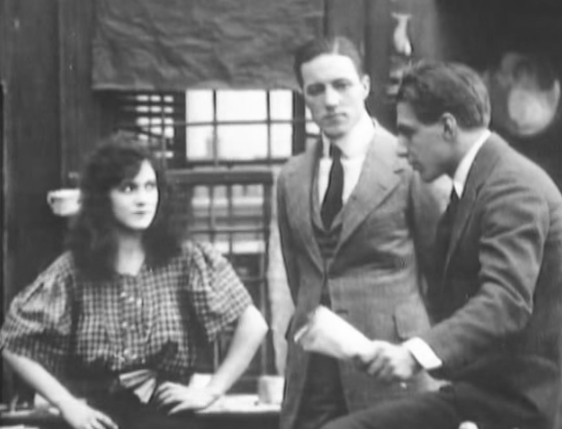
John H. Collins (right) directs Robert Walker and Viola Dana for Blue Jeans.
The story centers on June, a homeless waif wandering in rural Indiana. One day, June happens to meet local lawyer and aspiring politician Perry Bascom, who apparently likes to take a long lunch in the fields. Starving June tries to steal his cake… and his sandwich… and his apple.
When Bascom begins to lecture her, she tells him all about her hard-knocks life, the death of her mother, and her run-in with police brutality. Bascom understandably feels like a jerk, and, moved by her circumstances, he helps her get a job in the town where he lives. June also moves in with an elderly couple who lost their daughter (read: kicked her out when she got pregnant outside of wedlock) who happened to look an awful lot like June’s mother…
June and Bascom fall in love and secretly marry. Little does June know that Bascom is already married—albeit in an invalid union to a bigamist—and that he may be related to the n’er-do-well who impregnated and abandoned June’s mother.
Bascom’s wicked political rival Boone cannily exposes this news on election day and swings the vote, prompting the defeated politician to depart and hunt down proof of his innocence. Meanwhile, ostracized by the townsfolk, June cares for her newborn baby alone.

From its first shot, which introduces June, Blue Jeans challenges traditional notions of femininity and suggests the complexity of its protagonist. The audience initially sees her in a long shot from behind: an androgynous bundle of denim and flannel hunched on a fence. The next shot comes as something of a surprise: the face of girl too young to be wearing such a look of weary sadness.
By portraying June from two different, conflicting sides and forcing the spectator to reconcile them, Collins presents her as both a seasoned vagabond and a fragile teenager. We see her as a person first and a woman second. Her identity is not bounded by her beauty. She is a survivor above all, and many things besides.
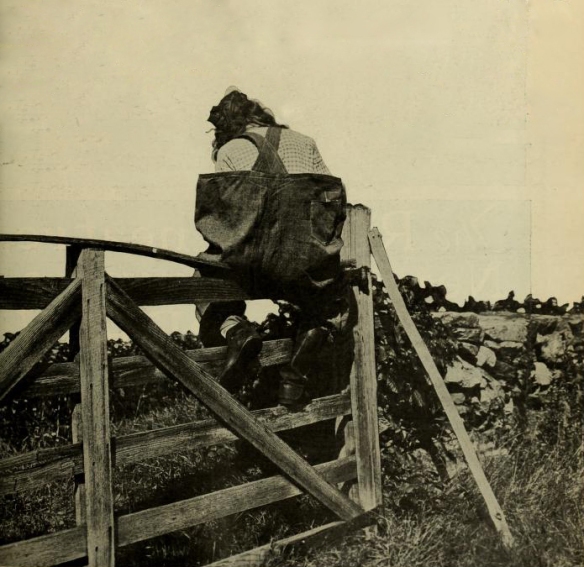
The film’s opening also calls out the dubious politics of empathy. Our first view of her is distant and distancing. It acquires pathos only retroactively through the second image, a close-up that draws us into June’s emotional state. Nobody cares about a shapeless unfortunate in overalls, but our hearts go out to a pretty girl in distress. Taken together, the two shots deliver a subtle social criticism, revealing how easy it is to ignore the plight of a displaced girl like June.
Collins reserves the most damning social criticism for the scenes in which June herself is condemned, first by her grandfather, second by her minister. As it turns out, the elderly couple that agreed to house June are her grandparents. When they discover Bascom’s identity, they forbid June from going to live with them. June trusts her husband and refuses to listen to her grandfather’s commands. The old man strikes June on the cheek, declaring, “I never want to see you and I never want to hear from you again!”
Throughout the renunciation scene, Collins pulls the audience into the heroine’s anguish through 3 or 4 extreme close-ups of June with large teardrops quivering on her cheeks. These shots, foreshadowing the surreal melancholy of Man Ray’s photograph “Larmes,” transfigure June’s pain, imbuing her with the aura of a weeping saint. The universality of her suffering blazes off the screen and accuses the inhumanity and inflexibility of her grandfather.
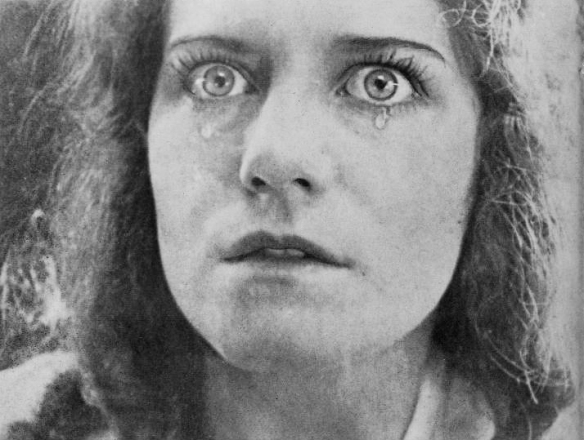
The old man’s “morality” really boils down to a kind of possessive pride, the desire to control the women in his life and ensure that they don’t reflect negatively on him. His warped sense of honor erases the compassion he should feel for his own flesh and blood—whether she disobeys him or not.
In a later scene, June’s grandmother finds the courage to break with her husband’s orders and bring food to June, eventually bringing about a reunion. The wisdom, forgiveness, and tenderness of women triumphs over the rigid, selfish ethics of a patriarchal society.
June faces humiliation again when she carries her baby, considered illegitimate by the townsfolk, to the church to have her baptized. The minister refuses the young mother, coldly pronouncing, “She is damned.” No one in the church moves a muscle to defend June, save her grandmother who is quickly restrained by the old man.
As a rebuke to the closed-mindedness of the village, Collins reveals a stained-glass window in the church that shows Jesus with the verse, “Suffer the little children to come unto me.” The so-called good Christians in the pews have failed to observe Christ’s teachings.

Though mistreated, June is much more than a symbolic martyr. Dana communicates her confusion, her love for her child, and her fear over what will happen to both of them with gut-wrenching naturalism. Collins illuminates the paradox of Dana’s face, possessed of girlish round cheeks and womanly, dolorous eyes. She’s little more than a child herself, we realize, and Dana ploughs into the character’s devastation with the honesty and unselfconsciousness that we expect from the unvarnished June. It’s as though we’ve sneaked into this woman’s life and watch as mute, ghostly spectators, unable to help.
Choking back tears as she rocks her unbaptized baby in a cradle, June expresses the very real hardship that unwed mothers endured—and continue to endure.
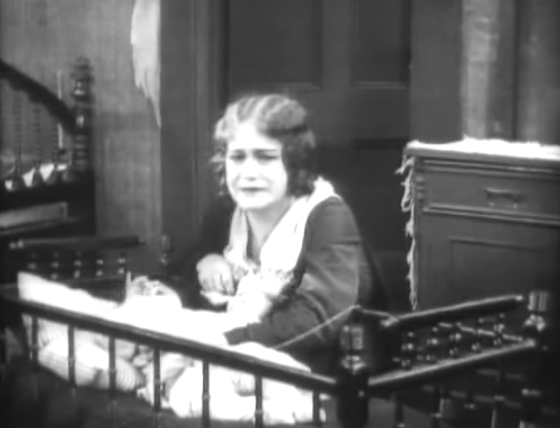
June’s emotions do not classify her as a victim, but rather call attention to her fortitude, to the quiet, maternal strength that doesn’t call attention to itself as much as the derring-do associated with male bravery. However, in the movie’s final act, Dana gets to demonstrate that more active kind of courage, as well.
Since Brownlow and Gill’s documentary included the famous sawmill scene, I’ve been able to extract it for your edification (with Carl Davis score, no less).
Notice the dizzying pace of the editing and how Collins juggles at least 3 trajectories throughout the whole sequence: the escaping villains, the unconscious hero, and the desperate heroine.
Of all the “threads” interwoven in this short sequence, June gets the most time, as she struggles to escape the locked room and save her husband. On a stage we wouldn’t see her, but here she’s the focus of our attention, the single variable that determines the outcome of the whole equation.
When we’re with her, we can’t see the blade; we don’t know how much time she has left and share her anxiety. The rhythm of the cutting pulses adrenaline through the viewer’s veins and cements our identification with June—waif, wife, mother, survivor, martyr, heroine, and lone voice of logic in a mean, bad world.
So, watch the clip. Share it. Let’s slice a silent movie myth to smithereens.
This post is part of the Anti-Damsel blogathon hosted by Movies Silently and The Last Drive-In. Check out the other entries about badass babes of the silver screen!



Thanks so much for joining in with this gem. It looks fantastic and I’m so glad that it lived up to expectations.
And she does it all while wearing a cumbersome long dress too! Chaste and brave! 😛
I’d not seen that before and I found myself quite enthralled and excited by the scene thanks to the ingenious editing. Audiences in 1917 must have soiled a few cinema seats while watching this! 😉
Good post, thanks for sharing it with us! 🙂
Great post. Thanks for sharing. I don’t think you participated in my Barrymore blogathon last week, but I would like to let you know about my new blogathon I’ve announced. You are more than welcome to participate. The link is below with more details
Wow. That was a nice study of a story that was big on stage and screen. I’m glad you included the clip with the sawmill scene. Viola Dana was wonderful.
Is this films somehow available?
Alas, it is not. I was lucky to see it at a festival of rare films. The print I watched was from the George Eastman House. I’d contact them about the possibility of having it screened if you need to see it for research purposes.